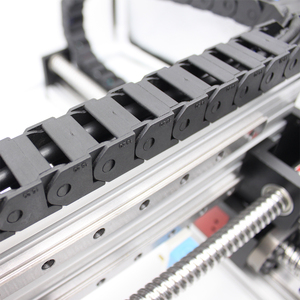
All categories
Featured selections
Trade Assurance
Buyer Central
Help Center
Get the app
Become a supplier

(1097 products available)



















A Gantry system refers to the design of moving or positioning components on the machine. They can have various axis combinations depending on the application. An example of a common Gantry system is the 2D Gantry System, which features the following two-axis setups:
Though widely used, the 2D Gantry system may not suit applications where the object area needs to improve or where higher speeds and acceleration need to be better. Here the following 3D Gantry Systems come in:
The above-mentioned 3D Gantry systems are just some examples of how machines can be structured to have more degree motion combinations. Other configurations can also be functional depending on the industry.
Load capacity:
The load capacity is the heaviest weight that the gantry system can move. It is usually measured in kilograms or tons. For example, a gantry system may have a load capacity of 2000 kg, which means it can handle loads weighing up to 2000 kg.
Height:
The height of the gantry system refers to the vertical distance from the ground to the top of the structure. This determines how high the system can lift items. For instance, a gantry system may stand at a height of 3 meters, enabling it to pick up objects that are up to 3 meters in height.
Track length:
The track length indicates the distance over which the gantry system can move horizontally. It defines the working area of the system. A gantry with a track length of 5 meters means it can move from one end to another across a 5-meter span.
Speed:
This is the rate at which the gantry system moves loads, expressed in meters per minute or similar units. For example, if a gantry crane has a travel speed of 10 meters per minute, it means that the crane moves at a rate of 10 meters every minute.
Controls:
The gantry system is usually controlled via remote control or a touch screen. This part is in charge of the instructions for moving and positioning the cargo. For example, the remote may have buttons for lifting, lowering, and moving it to the right or left.
It is crucial to follow the maintenance requirements for a gantry lifting system to keep it working well and prevent any breakdowns. Some important maintenance tips are as follows:
Metalworking industry:
In manufacturing industries such as steel making, iron casting, machinery manufacturing and equipment maintenance, gantry cranes are an indispensable tool. They are widely used for equipment installation, product lifting, transportation, loading and unloading.
Construction industry:
Gantry cranes are widely used in construction projects such as high-rise construction, bridge construction and infrastructure development. They are used for lifting heavy construction materials, installation of equipment and special vehicles.
Logistics and warehousing:
In the field of logistics and warehousing, gantry cranes are commonly used for stacking, loading and unloading, and handling of goods.
Offshore and maritime:
Gantry cranes play a pivotal role in the offshore and maritime sectors, where they are commonly used in areas such as ports and dockyards, as well as at sea. For instance, in port and dockyard facilities, gantry cranes may be employed to handle containers, mooring ships, and conduct salvage operations. Meanwhile, in offshore settings, they could be utilized for tasks such as assembling oil rigs and handling maritime equipment.
Automotive industry:
In automotive manufacturing plants, gantry cranes are widely used for assembly, maintenance and quality inspection of vehicles.
Clean room industry:
Food and beverage industry:
In the food and beverage industry, gantry systems are widely used in such scenarios as production line installation and maintenance, equipment transfer and lifting, and boiler maintenance.
Pharmaceutical industry:
In pharmaceutical production, gantry cranes are widely used in equipment transfer, clean room maintenance, production line installation and lifting.
Among the many options available for a gantry machine project, there are a few key factors to help narrow down the choices.
Q1: What is the difference between a gantry and an archway?
A1: A gantry is a frame designed to support or move an object. It has vertical and horizontal components. An archway is an opening constructed in an arch form. In most cases, it only has a curved top and does not have any vertical support components.
Q2: What are the three main parts of a gantry structure?
A2: A gantry typically has three main components: vertical legs, crossbeam, and a support element. The vertical legs are mounted or fixed at certain points to move or carry a load. They are usually mounted to the ground. The crossbeam is the horizontal part of the gantry that spans over the items being moved or supported. It is also known as the horizontal member. The support element connects the vertical legs and crossbeam. It usually holds the object or load to be lifted.
Q3: What are the factors to consider when choosing a gantry system for an application?
A3: Several factors need to be considered when selecting a gantry system for an application. They include weight capacity, degree of motion required, distance to traverse, power source, and mounting options. The weight capacity of the gantry system must be in line with the weight of the objects to be moved or lifted. The degree of motion refers to whether linear or rotational movement is required. If a linear motion is needed, a linear gantry system should be considered. It should also have the right specifications to achieve the desired degree of motion. If a rotational movement is required, an articulated gantry system should be considered. The distance that needs to be traversed will determine if a short or long gantry system will be suitable for the application. The area of installation will also affect the choice of gantry system. For example, if the system needs to be installed on a wall or ceiling, the gantry system should have the right mounting options for these surfaces.